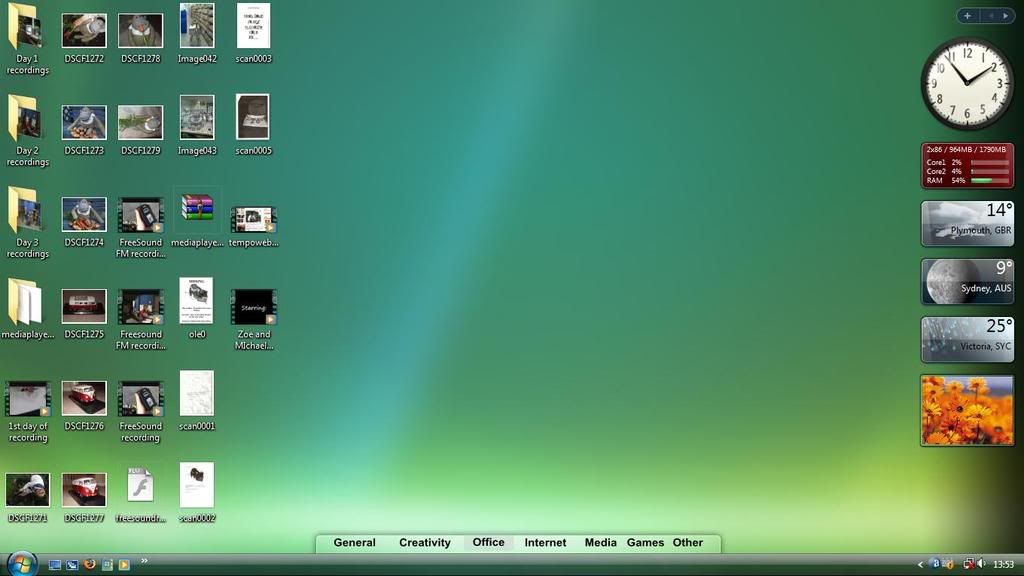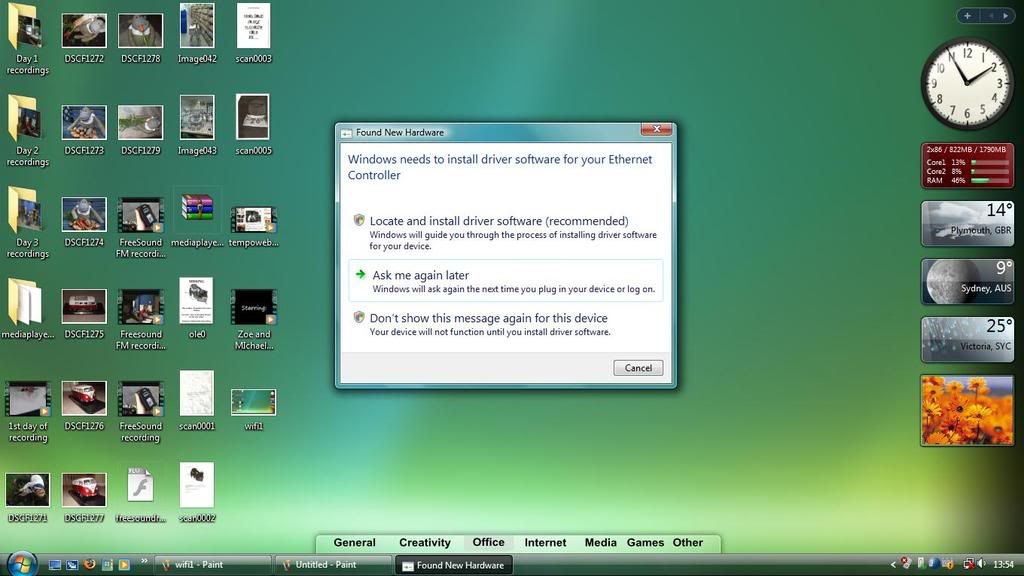Wrong! For years now MythTV has been arguably the best way of watching media in a dedicated environment. But it's just so damn hard to install and configure that most Linux users don't give it a chance. This vacuum of media centers on our beloved platform is about to get filled however.
The 1st option for a Linux media center is still MythTV, I heard you roll your eyes! The difference is that this version of MythTV comes with a buntu suffix. Mythbuntu is a tailor made ubuntu variant which is built from the ground up to support MythTV's ever growing list of features. And although it doesn't run as a liveCD if your building a dedicated media machine your not going to mind too much.
However if your not quite ready to replace your current Linux install with a media center and you don't want to go down the dual booting root then the next 2 options are right up your street.
The XBMC project started out as a hack for the original Xbox to turn it into a quiet and (relatively) small media center PC. The project since, however, has grown exponentially and now supports Windows, Mac, Linux, Xbox (original) and even the Apple TV. Thanks to its roots the project has a number of very good hardware and software hackers in its community and has enough skins (themes) and applications to rival MythTV.
A spin off project from XBMC comes in the form of Boxee which is a sort of social media center allowing users to rate, comment on and suggest films to other users. This social element is carried on with intergration into Twitter as well as integration with Last.fm, Flikr and for all you luck Americans Hulu! Yep free streaming movies and TV through your media center! You get all this AND the software is still only in private alpha. However you can register to take part in the alpha at the address below. For an alpha it is incredibly stable, probably because of its XBMC roots so there should be few worries over hardware compatibility.
I personally use Boxee as the user interface is very slick and the social watching element appeals to me. So if your also a Boxee user my username is, as ever, grindboy so please feel free to add me.
Links!
Mythbuntu: http://www.mythbuntu.org/
XBMC: http://xbmc.org/
Boxee: http://boxee.tv/
Monday, 27 October 2008
Sunday, 21 September 2008
Yay Miro's back
Hi guys just a quickie. After upgrading to 8.04 I never bothered to install Miro again. However today I tried it again and found that the installation is even easier than before! (And it was pretty easy then)
The instructions can be found here and they could not be simpler.
So download it now and enjoy access to video podcasts and internet TV
View my original review here
The instructions can be found here and they could not be simpler.
So download it now and enjoy access to video podcasts and internet TV
View my original review here
Tuesday, 16 September 2008
More changes!
So after having installed Ubuntu 8.04 from scratch on my desktop and solving all my problems it was time to solve all my eeepc's problems! Step up to the mark EEEbuntu a version of Ubuntu 8.04 designed solely for use on the eeepc. The version I'm using is the Netbook Remix edition. Just going to start installation now... Wish me luck!
[edit] The installation went flawlessly and even preserved my original home directory! The Netbook Remix user interface is so sleek and very user friendly.


 Boot takes 50 to 60 seconds! My wifi is picked up on boot rather that 47 seconds later as with Xandros. I've got CPU scaling, something which I never thought about but I'm sure will help my battery life. Sound, function keys, Wireless all works and my battery meter is finally giving me sensible estimates as apposed to "you have 1 minute of battery left (100%)". The UME launcher is a god send and I can finally use Tomboy which I was unable to install on Xandros due to my screwing up of synaptic :-s
Boot takes 50 to 60 seconds! My wifi is picked up on boot rather that 47 seconds later as with Xandros. I've got CPU scaling, something which I never thought about but I'm sure will help my battery life. Sound, function keys, Wireless all works and my battery meter is finally giving me sensible estimates as apposed to "you have 1 minute of battery left (100%)". The UME launcher is a god send and I can finally use Tomboy which I was unable to install on Xandros due to my screwing up of synaptic :-s
All in all I'm very happy with the distro and the support on the Eeebuntu forums appears to be as good as Ubuntu's own forums.
[edit] The installation went flawlessly and even preserved my original home directory! The Netbook Remix user interface is so sleek and very user friendly.


 Boot takes 50 to 60 seconds! My wifi is picked up on boot rather that 47 seconds later as with Xandros. I've got CPU scaling, something which I never thought about but I'm sure will help my battery life. Sound, function keys, Wireless all works and my battery meter is finally giving me sensible estimates as apposed to "you have 1 minute of battery left (100%)". The UME launcher is a god send and I can finally use Tomboy which I was unable to install on Xandros due to my screwing up of synaptic :-s
Boot takes 50 to 60 seconds! My wifi is picked up on boot rather that 47 seconds later as with Xandros. I've got CPU scaling, something which I never thought about but I'm sure will help my battery life. Sound, function keys, Wireless all works and my battery meter is finally giving me sensible estimates as apposed to "you have 1 minute of battery left (100%)". The UME launcher is a god send and I can finally use Tomboy which I was unable to install on Xandros due to my screwing up of synaptic :-sAll in all I'm very happy with the distro and the support on the Eeebuntu forums appears to be as good as Ubuntu's own forums.
Monday, 8 September 2008
I think we're back in bussiness
So installations all done. And now I've got my distro looking how I want it:
 I really like the black Mac OSX look. I think Apple should make it so you can have different colour schemes for Macs.
I really like the black Mac OSX look. I think Apple should make it so you can have different colour schemes for Macs.
Anyway I figured out where I got the wallpaper from.
http://ve1n.deviantart.com/art/A-E-R-O-S-T-R-E-A-M-70590157
It's called AEROSTREAM and its by ve1n. It comes in 6 colours and tonnes of resolutions. so theres sure to be one for your tastes and screen size
And like the end of looney toons:
Tha..Tha..Tha..That's all folks!
 I really like the black Mac OSX look. I think Apple should make it so you can have different colour schemes for Macs.
I really like the black Mac OSX look. I think Apple should make it so you can have different colour schemes for Macs.Anyway I figured out where I got the wallpaper from.
http://ve1n.deviantart.com/art/A-E-R-O-S-T-R-E-A-M-70590157
It's called AEROSTREAM and its by ve1n. It comes in 6 colours and tonnes of resolutions. so theres sure to be one for your tastes and screen size
And like the end of looney toons:
Tha..Tha..Tha..That's all folks!
Thursday, 4 September 2008
Wifi Woes!
Ok, so the story goes that I installed Ubuntu 8.04 Hardy Heron through the update feature in the update manager. Now ever since then there have been a few niggling issues that I've ignored. But today my WiFi which had installed so perfectly has packed up and left! I've tried just about everything I've found on the Ubuntu Forums including NdisWrapper, MadWiFi and many others. Nothing works (hence I'm posting this from my EEE). So being as I'm at my wits end I'm going to install Ubuntu 8.04 from fresh. I've moved all my important stuff from my /home directory to my Vista and now I'm going to start over. Hopefully this will mean that all those niggling problems are sorted out in the process. See you on the other side!
[edit] Just over halfway through the install now at 11 minutes and 35 seconds. All going smoothly so far.
[edit2] installation complete at 17:30.3 restarting now
[edit 3] Vistas fine. Some odd grub errors Uh oh.
[edit 4] Grub boots fine from Vista harddrive but not the Ubuntu one! Strange but true!
[edit 5] Insallation complete at 24 minutes 3 seconds and 1 millisecond!
[edit] Just over halfway through the install now at 11 minutes and 35 seconds. All going smoothly so far.
[edit2] installation complete at 17:30.3 restarting now
[edit 3] Vistas fine. Some odd grub errors Uh oh.
[edit 4] Grub boots fine from Vista harddrive but not the Ubuntu one! Strange but true!
[edit 5] Insallation complete at 24 minutes 3 seconds and 1 millisecond!
Monday, 18 August 2008
MMMM 802.11!
I signed up with Virgin Media for a new fibre optic, stupidly fast, broadband connection. However the new modem thingy (Cable connection in>Coax TV cable and Ethernet out) is in my living room with my desktop 1 floor up and a bit to the right! So only one thing for it... Wireless!
First I searched the Ubuntu Hardware Compatibility list and found a card that "should" work out of the box. But as we all know Linux=Variety so just because the test box worked with the card out of the box didn't mean mine would. So I ordered the card from Amazon and it arrived today. I fitted it and booted the PC. Boot time was a little bit longer than usual due to it finding the new hardware (Good sign), desktop loads, compiz loads, network manager loads... and asks me which wireless network I wanted to connect to! *HUGE SMILE*
I also ordered an Xbox 360 wireless adapter (yes I know its Microsoft but I just don't like the PS3 even if it is far more Linux friendly). The installation took a similar time, but connecting to the network took much longer! Ubuntu with 3rd party hardware and drivers beats the Xbox OS when its running 1st party hardware and drivers! We'll see if the differences continue as I'm now going to boot Vista and see if the installation is as easy...
Huge gr't big update
Well as expected Vista threw a fit! The process can only be described in screenshots so without further adieu:
First I searched the Ubuntu Hardware Compatibility list and found a card that "should" work out of the box. But as we all know Linux=Variety so just because the test box worked with the card out of the box didn't mean mine would. So I ordered the card from Amazon and it arrived today. I fitted it and booted the PC. Boot time was a little bit longer than usual due to it finding the new hardware (Good sign), desktop loads, compiz loads, network manager loads... and asks me which wireless network I wanted to connect to! *HUGE SMILE*
I also ordered an Xbox 360 wireless adapter (yes I know its Microsoft but I just don't like the PS3 even if it is far more Linux friendly). The installation took a similar time, but connecting to the network took much longer! Ubuntu with 3rd party hardware and drivers beats the Xbox OS when its running 1st party hardware and drivers! We'll see if the differences continue as I'm now going to boot Vista and see if the installation is as easy...
Huge gr't big update
Well as expected Vista threw a fit! The process can only be described in screenshots so without further adieu:
Oh yes please Mr Vista sir please install my device!
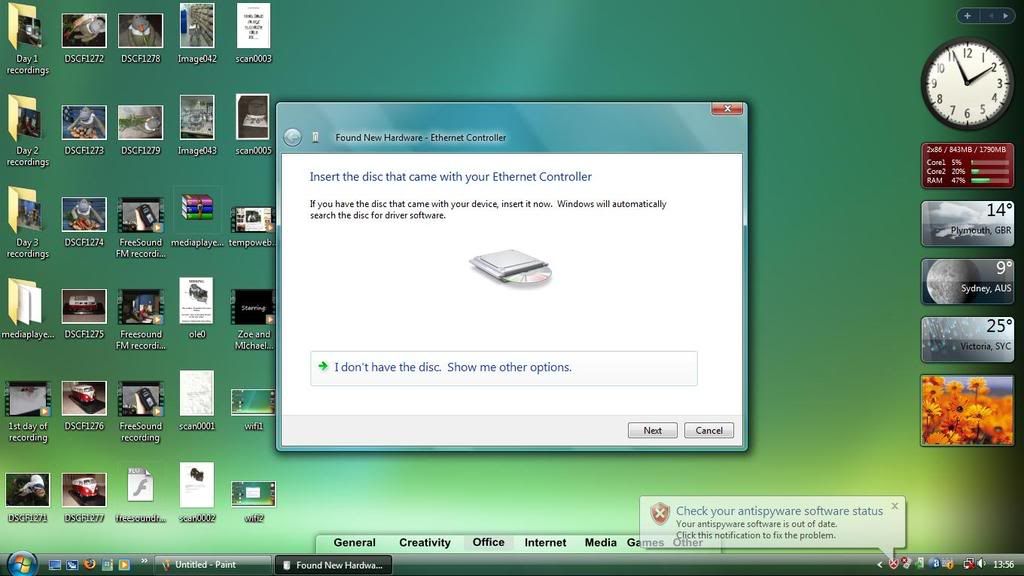 This dialogue box is understandable as Windows doesn't
This dialogue box is understandable as Windows doesn't
have repositories to turn to.
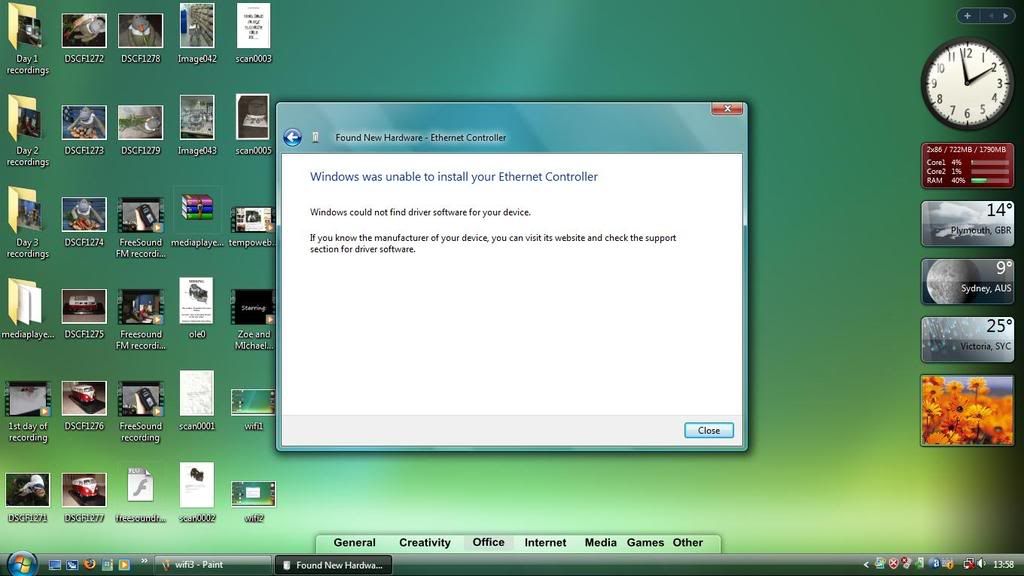 Bugger! Right where's the CD's installer
Bugger! Right where's the CD's installer
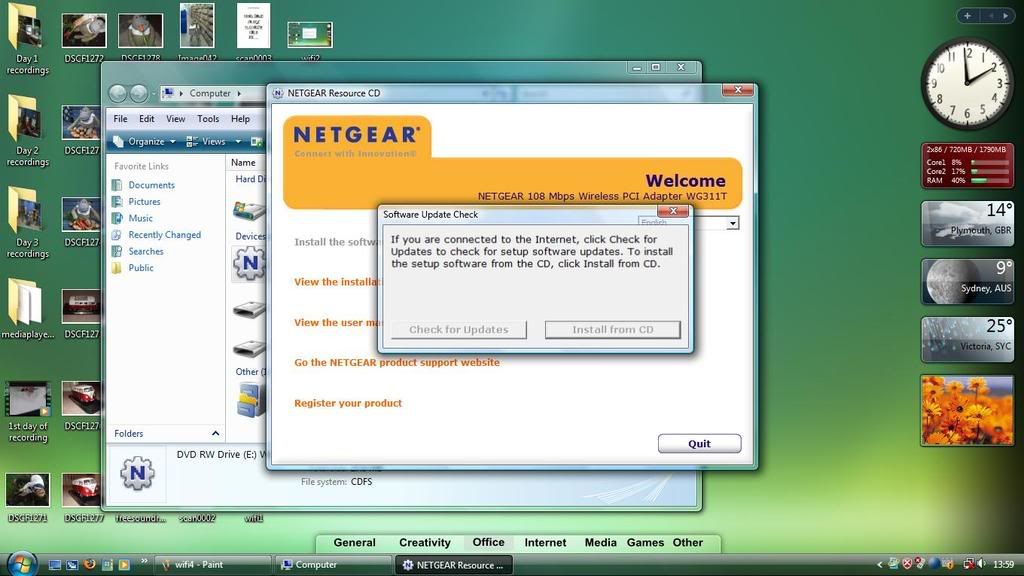 This looks slightly more promising
This looks slightly more promising
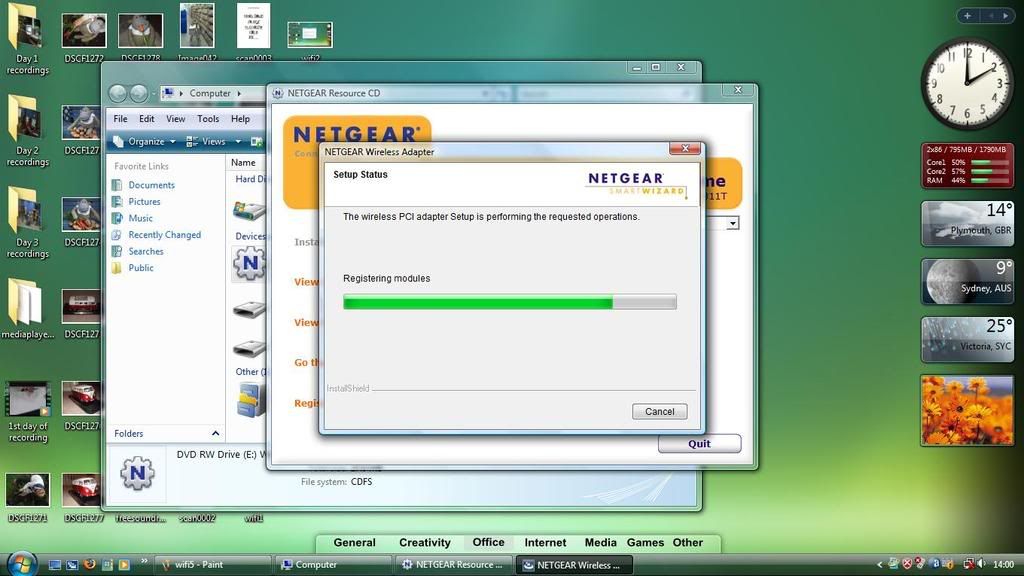 Did I mention I hate waiting?
Did I mention I hate waiting?
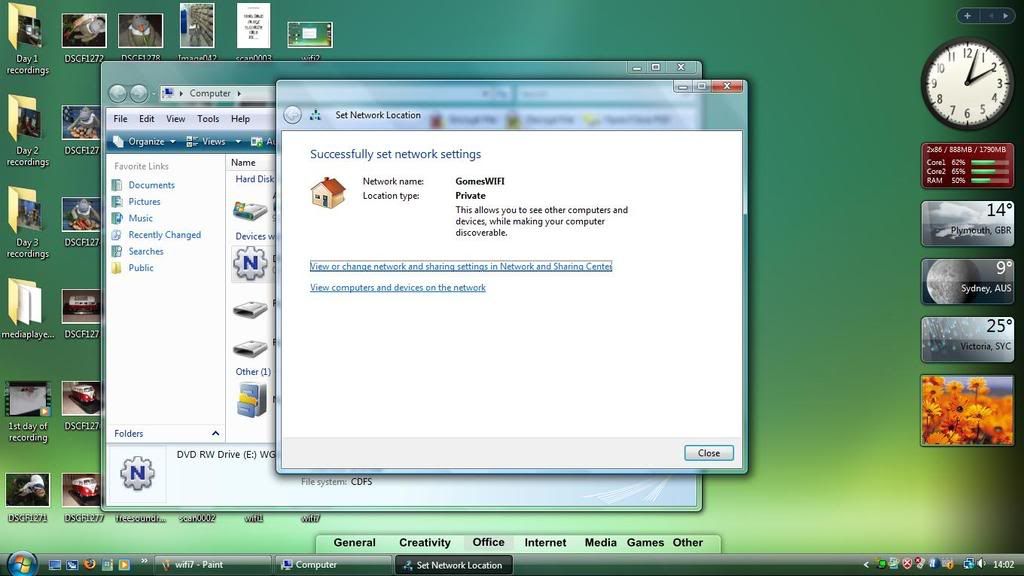 Woo Hoo!
Woo Hoo!
 This dialogue box is understandable as Windows doesn't
This dialogue box is understandable as Windows doesn'thave repositories to turn to.
 Bugger! Right where's the CD's installer
Bugger! Right where's the CD's installer This looks slightly more promising
This looks slightly more promising Did I mention I hate waiting?
Did I mention I hate waiting? Woo Hoo!
Woo Hoo! So it took Windows Vista 10 minutes and lots of clicking "next" to do what Ubuntu did on startup! Another point for Linux I think.
Now if only I can figure out why my EEE is taking 8 minutes to connect to my network I'll be very happy :-)
Now if only I can figure out why my EEE is taking 8 minutes to connect to my network I'll be very happy :-)
Tuesday, 8 July 2008
Sometimes it's the little things...
One of the reasons I love Linux is for the community. I recently bought an eee pc. 1st thing I did was switch to advanced mode and I found out how to do this by asking the eee pc community (http://www.eeeuser.com). Next I decided I decided I didn't like KDE so again with the help of the forums I installed gnome. The same went for compiz and a certain black border problem you get when running compiz on the eee pc (that particular problem required the help of both the eeeuser community and the compiz one. So when my WIFI packed up for no apparent reason I felt confident in going to the forums to do battle with the commandline and bios (the whole 9 yards!) only to find that the problem could be fixed by taking out the battery, holding down the power button for 15 seconds and restarting the computer!
Thats why I love Linux. Microsoft and other large companies (including Asus) would have said reinstall this, upgrade that, pay us more. Linux says "this little trick worked for me it might do the same for you"
Special thanks goes to gtisingh of eeeuser.com for getting my WIFI working again!
Thats why I love Linux. Microsoft and other large companies (including Asus) would have said reinstall this, upgrade that, pay us more. Linux says "this little trick worked for me it might do the same for you"
Special thanks goes to gtisingh of eeeuser.com for getting my WIFI working again!
Saturday, 3 May 2008
8.04 update
Just a quick update on the issues I was having with emerald and Ubuntu 8.04 Hardy Heron. The solution was to download a rather nice GTK 2.x theme instead of mucking around with emerald!
Friday, 2 May 2008
Ubuntu 8.04 upgrade
My next post was going to be about opensource software for university but I recently upgraded my Ubuntu distro from 7.10 Gutsy to 8.04LTS Hardy. The actual process of upgrading was painless and simple but horrifyingly slow!
The installation
Proof I was running 7.10:
 The process starts off by going to the Update Manger (system>administration>update manager) and clicking on "upgrade"
The process starts off by going to the Update Manger (system>administration>update manager) and clicking on "upgrade"
 It then shows you the release notes:
It then shows you the release notes:
 Before downloading the upgrade tool:
Before downloading the upgrade tool:
 The upgrade tool will configure a couple of things before downloading all the packages
The upgrade tool will configure a couple of things before downloading all the packages
Which in my case took this long:
 Not only did I go and make a sandwich but I also watched TV, played Halo 3, fixed some things on one of my websites, ate said sandwich, fell asleep, read 6 chapters of my book... the list goes on. And the moral is this, if your internet connection is as slow as mine... get a free CD from here it's only 6 to 8 weeks for delivery!
Not only did I go and make a sandwich but I also watched TV, played Halo 3, fixed some things on one of my websites, ate said sandwich, fell asleep, read 6 chapters of my book... the list goes on. And the moral is this, if your internet connection is as slow as mine... get a free CD from here it's only 6 to 8 weeks for delivery!
Finally the upgrade tool got round to doing some upgrading. This took a far more respectable 45 minutes. The system was then rebooted.
Post install
The first thing I noticed was a much faster boot time. The installation had completely ignored my custom resolution so I was given some horrible stretchy pixels on reaching the desktop. However Hardy handles resolutions better than Gutsy and within a few clicks I had 1360x768 back. In Gutsy it took me a couple of hours and a lot of digging around in xorg.conf to get that resolution.
The second thing I noticed is that I'm now running Firefox 3 beta 5 instead of the trusty Firefox 2.0. It's nice but I'm not sure I like the fact that I wasn't asked whether I wanted it or not, I was going to hold out until it was out of beta.
 There was a problem with emerald and 8.04 which I found a temporary fix to. Not sure if its done the trick as the word on the web it that the solution doesn't survive a re-boot but hopefully I can find a more permanent solution.
There was a problem with emerald and 8.04 which I found a temporary fix to. Not sure if its done the trick as the word on the web it that the solution doesn't survive a re-boot but hopefully I can find a more permanent solution.
Other than the odd graphical glitch during the installation the process was smooth and I'm happy with the result. I mean who would expect no glitches whist updating an OS while running it! I'd like to see Microsoft do that!

The installation
Proof I was running 7.10:
 The process starts off by going to the Update Manger (system>administration>update manager) and clicking on "upgrade"
The process starts off by going to the Update Manger (system>administration>update manager) and clicking on "upgrade" It then shows you the release notes:
It then shows you the release notes: Before downloading the upgrade tool:
Before downloading the upgrade tool: The upgrade tool will configure a couple of things before downloading all the packages
The upgrade tool will configure a couple of things before downloading all the packagesWhich in my case took this long:
 Not only did I go and make a sandwich but I also watched TV, played Halo 3, fixed some things on one of my websites, ate said sandwich, fell asleep, read 6 chapters of my book... the list goes on. And the moral is this, if your internet connection is as slow as mine... get a free CD from here it's only 6 to 8 weeks for delivery!
Not only did I go and make a sandwich but I also watched TV, played Halo 3, fixed some things on one of my websites, ate said sandwich, fell asleep, read 6 chapters of my book... the list goes on. And the moral is this, if your internet connection is as slow as mine... get a free CD from here it's only 6 to 8 weeks for delivery!Finally the upgrade tool got round to doing some upgrading. This took a far more respectable 45 minutes. The system was then rebooted.
Post install
The first thing I noticed was a much faster boot time. The installation had completely ignored my custom resolution so I was given some horrible stretchy pixels on reaching the desktop. However Hardy handles resolutions better than Gutsy and within a few clicks I had 1360x768 back. In Gutsy it took me a couple of hours and a lot of digging around in xorg.conf to get that resolution.
The second thing I noticed is that I'm now running Firefox 3 beta 5 instead of the trusty Firefox 2.0. It's nice but I'm not sure I like the fact that I wasn't asked whether I wanted it or not, I was going to hold out until it was out of beta.
 There was a problem with emerald and 8.04 which I found a temporary fix to. Not sure if its done the trick as the word on the web it that the solution doesn't survive a re-boot but hopefully I can find a more permanent solution.
There was a problem with emerald and 8.04 which I found a temporary fix to. Not sure if its done the trick as the word on the web it that the solution doesn't survive a re-boot but hopefully I can find a more permanent solution.Other than the odd graphical glitch during the installation the process was smooth and I'm happy with the result. I mean who would expect no glitches whist updating an OS while running it! I'd like to see Microsoft do that!

Saturday, 19 April 2008
Be ready for University opensource style!
Part 1: Hardware
With only 5 months left till many students join university the race is on to get organised. And where better to start than with hardware. It would be nigh on impossible for you to get though university without going near a computer. So why leave your open source life at home? You home PC is probably running a Linux Distro or at the least some opensource software so why shouldn't your laptop? So what are the best laptops to buy that either come with Linux or are easy to add Linux to.
1st up is the Asus EEE Pc this laptop steals the show on portability and price. Prices start at £219 for the 4G Surf model which features a 4GB SSD (Solid State Disk) and 7 inch screen but no webcam. More expensive models have a webcam, larger SSD and a larger screen. The laptop comes with a modified version of the Xandros distro which has a very simple user interface but a one line command to teminal will give you a full IceWM desktop. All the normal free software is included such as firefox, openoffice and skype along with a number of educational programs and a webcam capture program.
If you don't like the eee pc's small keyboard and screen but don't want to spend a lot more then you might consider Dells offerings on Ubuntu based PCs. For an extra £80 you can have a 15.4" widescreen, full sized keyboard, 80GB hard drive and an 8xDVD+/-RW drive. This set-up comes with Ubuntu 7.10 pre-installed meaning that all the hardware works! You can customise your laptop easily with Dell's "Build your system" erm... system meaning you can add bluetooth, a 2MP webcam more ram etc. really easily.
If you don't like buying something opensource from a giant like Dell or would like to spend a bit more on you laptop then one make has always been synonymous with laptops and Linux is the Thinkpad originally made by IBM the franchise is now owned by Lenovo. Now apparently they sell the Thinkpad T61 with Suse pre-installed but I've just spent the last hour trying to find the option for this but to no avail. In frustration I have now submitted feedback asking whether they still support Suse and if so where the option is. According to Linux format magazine they picked up a thinkpad for £425 with Suse included.
I'll update this post if and when Lenovo get back to me!
Update: Well Lenovo never did get back to me so at this point your best bet for a laptop with Linux pre-installed on it is going to be the Eee PC or Dell.
With only 5 months left till many students join university the race is on to get organised. And where better to start than with hardware. It would be nigh on impossible for you to get though university without going near a computer. So why leave your open source life at home? You home PC is probably running a Linux Distro or at the least some opensource software so why shouldn't your laptop? So what are the best laptops to buy that either come with Linux or are easy to add Linux to.
1st up is the Asus EEE Pc this laptop steals the show on portability and price. Prices start at £219 for the 4G Surf model which features a 4GB SSD (Solid State Disk) and 7 inch screen but no webcam. More expensive models have a webcam, larger SSD and a larger screen. The laptop comes with a modified version of the Xandros distro which has a very simple user interface but a one line command to teminal will give you a full IceWM desktop. All the normal free software is included such as firefox, openoffice and skype along with a number of educational programs and a webcam capture program.
If you don't like the eee pc's small keyboard and screen but don't want to spend a lot more then you might consider Dells offerings on Ubuntu based PCs. For an extra £80 you can have a 15.4" widescreen, full sized keyboard, 80GB hard drive and an 8xDVD+/-RW drive. This set-up comes with Ubuntu 7.10 pre-installed meaning that all the hardware works! You can customise your laptop easily with Dell's "Build your system" erm... system meaning you can add bluetooth, a 2MP webcam more ram etc. really easily.
If you don't like buying something opensource from a giant like Dell or would like to spend a bit more on you laptop then one make has always been synonymous with laptops and Linux is the Thinkpad originally made by IBM the franchise is now owned by Lenovo. Now apparently they sell the Thinkpad T61 with Suse pre-installed but I've just spent the last hour trying to find the option for this but to no avail. In frustration I have now submitted feedback asking whether they still support Suse and if so where the option is. According to Linux format magazine they picked up a thinkpad for £425 with Suse included.
I'll update this post if and when Lenovo get back to me!
Update: Well Lenovo never did get back to me so at this point your best bet for a laptop with Linux pre-installed on it is going to be the Eee PC or Dell.
Monday, 24 March 2008
Time for change
I haven't posted for a while because I'm very happy with my desktop. Until recently, when I found myself yearning for a dock, of all things. I have objectdock plus installed on my Vista partition and I used to use it a lot.
So being Linux I knew that someone will have made something similar for our OS. The two main docks are Kiba dock and AWN. I plumped for AWN as Kiba seems hugely difficult to install.
The installation only took 10 minutes and involved nothing more complicated than tapping a few commands into terminal.
And the result of fiddling with terminal for a bit is a hugely functional dock which even supports my last.fm account!


So being Linux I knew that someone will have made something similar for our OS. The two main docks are Kiba dock and AWN. I plumped for AWN as Kiba seems hugely difficult to install.
The installation only took 10 minutes and involved nothing more complicated than tapping a few commands into terminal.
And the result of fiddling with terminal for a bit is a hugely functional dock which even supports my last.fm account!


Saturday, 9 February 2008
A gamer huh? Well you won't want linux then!
For years Linux was for geeks. But no longer, the installation process is easy (on some distros it is easier than windows) and the GUI (graphical user interface) is simple to use and easy to understand.
But still people pick Windows. One reason for this is proprietary software like iTunes but one market we're missing out on is the gaming market. Windows still rules supreme among gamers but the truth is that Linux is the ONLY operating system that can use the latest hardware to its full potential. In 2007 Linux Format Magazine built a astronomically powerful gaming rig and ran Linux on it without a single hiccup, but aside from Planet Penguin Racer there are very few 3d games for Linux. Until now...
Cue Eve online... Eve online is a space based MMORPG (massive multiplayer online roleplaying game) It allows players to explore a giant universe of possibilities and it currently has 200,000 players all of whom play in the same universe, no sharding (where you are put on different servers). The game is as infinitely complex as real life, you can be a merchant, soldier, explorer or any number of other things. And the best bit is, it runs on Linux as well as Mac and PC. The installation was easy, you install the package from http://www.eve-online.com which then downloads and installs the game client:

Then you go back on the site and register for a 14 day free account, just so you can decide if you like it or not, then your ready to start playing. In ubuntu Eve automatically placed itself in the applications menu under games. Click this and up comes the game client, just log in with the account you just created and make your 1st character (you can have 3):
But still people pick Windows. One reason for this is proprietary software like iTunes but one market we're missing out on is the gaming market. Windows still rules supreme among gamers but the truth is that Linux is the ONLY operating system that can use the latest hardware to its full potential. In 2007 Linux Format Magazine built a astronomically powerful gaming rig and ran Linux on it without a single hiccup, but aside from Planet Penguin Racer there are very few 3d games for Linux. Until now...
Cue Eve online... Eve online is a space based MMORPG (massive multiplayer online roleplaying game) It allows players to explore a giant universe of possibilities and it currently has 200,000 players all of whom play in the same universe, no sharding (where you are put on different servers). The game is as infinitely complex as real life, you can be a merchant, soldier, explorer or any number of other things. And the best bit is, it runs on Linux as well as Mac and PC. The installation was easy, you install the package from http://www.eve-online.com which then downloads and installs the game client:

Then you go back on the site and register for a 14 day free account, just so you can decide if you like it or not, then your ready to start playing. In ubuntu Eve automatically placed itself in the applications menu under games. Click this and up comes the game client, just log in with the account you just created and make your 1st character (you can have 3):
Saturday, 26 January 2008
One Step Beyond!
OK, the only reason I still have Vista on my hard drive is because I own an iPod and because Apple in its infinite wisdom decided to make the entire device proprietary. As a result I have to run iTunes in order to get music onto my iPod.
Now there are a few possibilities when it come to running iTunes on Linux. The first would be for apple to make a version of iTunes for Linux, an idea that went up in flames when Apple went with DRM (Linux is far too open source). The second possibility is WINE (standing for Wine Is Not an Emulator) this program creates a windows compatibility layer between Linux and the program you are trying to run.
The program works a treat on most old programs, yeh OLD programs, this is fine if, like me, you learned web design, animation and image manipulation on Studio MX but if you need some of the newer iterations your stuffed! At one point the WINE team got iTunes working, but Apple are bringing out updates for the software so often that it wouldn't be viable for the team to try and keep up. If you have an old iPod (pre this generation, I think) then this option might be good for you.
I, however, went out and bought an iPod Touch the newest of the new. An iPod which wont run on any previous incarnations of iTunes. So whats my solution? VirtualBox.
VirtualBox is free Virtualization software which allows you to run an OS from inside an OS. This means I can run a full blown copy of XP inside Linux! At the moment of writing this I've still got some tweaking to do (such as install iTunes and figure why everything is running so slow!) but I'll get some screenshots up in a few hours.
UPDATE: I spent hours trying to get it working but only ended up in a frustrated mess of linux and windows command lines! So I've given up! I'll wait for WINE to support iTunes 7.whatever! In the mean time iTunes is still a reason to keep a windows partition :-(
Now there are a few possibilities when it come to running iTunes on Linux. The first would be for apple to make a version of iTunes for Linux, an idea that went up in flames when Apple went with DRM (Linux is far too open source). The second possibility is WINE (standing for Wine Is Not an Emulator) this program creates a windows compatibility layer between Linux and the program you are trying to run.
The program works a treat on most old programs, yeh OLD programs, this is fine if, like me, you learned web design, animation and image manipulation on Studio MX but if you need some of the newer iterations your stuffed! At one point the WINE team got iTunes working, but Apple are bringing out updates for the software so often that it wouldn't be viable for the team to try and keep up. If you have an old iPod (pre this generation, I think) then this option might be good for you.
I, however, went out and bought an iPod Touch the newest of the new. An iPod which wont run on any previous incarnations of iTunes. So whats my solution? VirtualBox.
VirtualBox is free Virtualization software which allows you to run an OS from inside an OS. This means I can run a full blown copy of XP inside Linux! At the moment of writing this I've still got some tweaking to do (such as install iTunes and figure why everything is running so slow!) but I'll get some screenshots up in a few hours.
UPDATE: I spent hours trying to get it working but only ended up in a frustrated mess of linux and windows command lines! So I've given up! I'll wait for WINE to support iTunes 7.whatever! In the mean time iTunes is still a reason to keep a windows partition :-(
Friday, 11 January 2008
All you internet video belong to us!
When I was a Windows user I stumbled across Democracy Player (now Miro) the program is just a video program that supports almost all video formats you can think of. I downloaded and installed it but at the time was unimpressed. I'm still however on their mailing list and now that the program is 1.1 I thought I'd give a another shot.
Installation seems easier on Ubuntu that it was on Vista, just a case of adding a repository and searching for the name of the program. (I love synaptic!)

The program then asked me where to search for media, I picked my Vista hard drive because thats where all my media is. Then after sorting through the files it could and couldn't play (when the program can't play a file it offers to play it through an external program instead) and the ones I didn't want cluttering up my playlist (like the raw footage from my YouTube videos) I started looking at the programs most impressive feature...
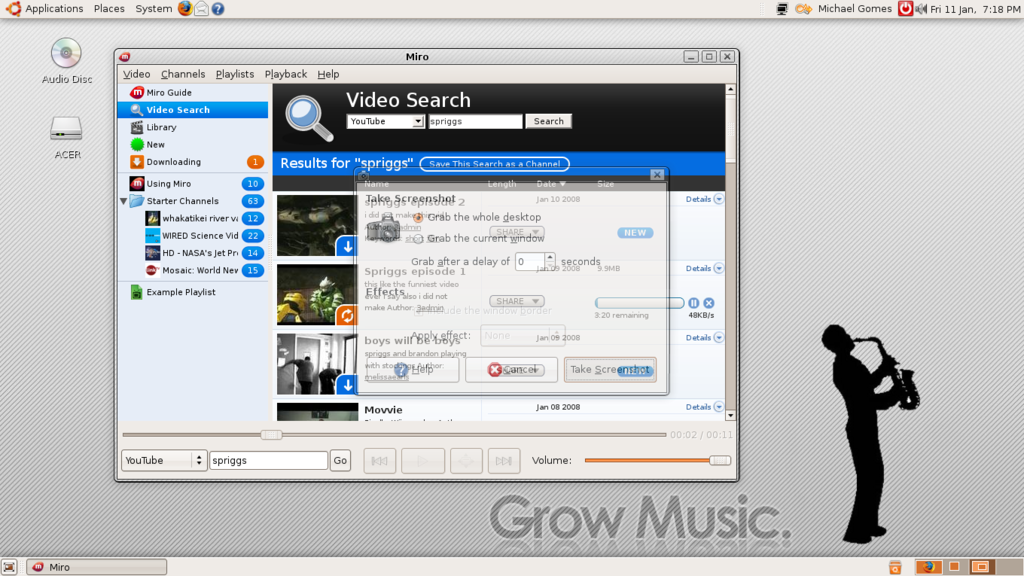
Internet TV, in a few clicks I had downloaded the latest episode of Spriggs (A Halo 3 machinima) from YouTube thats something you can' t do natively with YouTube!

Another great feature is Miro Guide which is basically video podcasting, within 3 minutes I'm subscribed to Cnet TV's Buzz Report just like in iTunes on Vista (But with fewer bugs!)
Linux is probably not going to get a all in one replacement for iTunes any time soon, but for all your video podcasting needs Miro is a brilliant program. I'm one step closer to ditching Windows for good!
P.S. Sorry about the stupid screenshot window in the pics obviously theres a timer function for a reason!
Installation seems easier on Ubuntu that it was on Vista, just a case of adding a repository and searching for the name of the program. (I love synaptic!)

The program then asked me where to search for media, I picked my Vista hard drive because thats where all my media is. Then after sorting through the files it could and couldn't play (when the program can't play a file it offers to play it through an external program instead) and the ones I didn't want cluttering up my playlist (like the raw footage from my YouTube videos) I started looking at the programs most impressive feature...

Internet TV, in a few clicks I had downloaded the latest episode of Spriggs (A Halo 3 machinima) from YouTube thats something you can' t do natively with YouTube!

Another great feature is Miro Guide which is basically video podcasting, within 3 minutes I'm subscribed to Cnet TV's Buzz Report just like in iTunes on Vista (But with fewer bugs!)
Linux is probably not going to get a all in one replacement for iTunes any time soon, but for all your video podcasting needs Miro is a brilliant program. I'm one step closer to ditching Windows for good!
P.S. Sorry about the stupid screenshot window in the pics obviously theres a timer function for a reason!
Saturday, 5 January 2008
Compiz Fusion goodness!
One LiveCD, Sabayon, ran perfectly on my mates laptop (Beryl and all) when I had to run it in safe graphics mode on my blindingly fast Vista machine! I understand now that even powerful laptops use fairly standard hardware so the developers of Sabayon were able to make it fully compatible with most laptops. In contrast desktops can have millions of different pieces of hardware in even more different configurations!
I had heard good things about Ubuntu so I asked for a free CD (A good way of getting into Linux without downloading the ISOs for hours) but the 6.2 disk I ordered wouldn't even run! Luckily they fixed this in 7.10 and I'm very happy with my installation of Gutsy Gibbon! As you can see from the screen shots below I got Compiz Fusion running, without much trouble, and I even have it optimized for my 32" LCD TV.
Although it was far easier to get Vista configured for my TV when you configure something in Linux you feel like you've achieved something, windows always seems to molly coddle a user holding their hand through every option with Linux you feel in control, powerful but still safe. I tried installing the screenletts sidebar recently and nearly broke Ubuntu, but the safety mesh stepped in and told me that what I was trying to do was dangerous long before I did any damage.
But if Ubuntu's so great why do I still have Vista? One word iTunes, I've got an iPod Touch which requires iTunes 7.5 (or whatever the latest version is) to sync but wine (a windows compatibility layer) doesn't support it yet. You can get the touch to sync with Amarok but it involves a lot of work and at the moment I'm quite happy to wait for the wine developers to do their magic.
I had heard good things about Ubuntu so I asked for a free CD (A good way of getting into Linux without downloading the ISOs for hours) but the 6.2 disk I ordered wouldn't even run! Luckily they fixed this in 7.10 and I'm very happy with my installation of Gutsy Gibbon! As you can see from the screen shots below I got Compiz Fusion running, without much trouble, and I even have it optimized for my 32" LCD TV.
Although it was far easier to get Vista configured for my TV when you configure something in Linux you feel like you've achieved something, windows always seems to molly coddle a user holding their hand through every option with Linux you feel in control, powerful but still safe. I tried installing the screenletts sidebar recently and nearly broke Ubuntu, but the safety mesh stepped in and told me that what I was trying to do was dangerous long before I did any damage.
But if Ubuntu's so great why do I still have Vista? One word iTunes, I've got an iPod Touch which requires iTunes 7.5 (or whatever the latest version is) to sync but wine (a windows compatibility layer) doesn't support it yet. You can get the touch to sync with Amarok but it involves a lot of work and at the moment I'm quite happy to wait for the wine developers to do their magic.
Thursday, 3 January 2008
Infinity + Freedom + Voice

So after looking around I plumped for Fedora Core 7 as my first Linux distro. The installation process was fairly quick but threw a fair amount of confusing Linux buzzwords at me. Eventually I had a working distro on my hands with only one problem, the internet. The modem I was using was a Sagem F@st 800 which is a USB ADSL modem, the only problem was this modem is notorious for not working with Linux. And with all things Linux, no drivers, no modem, no internet, no packages, no new programs and no fun. That wasn't a problem though as I had a fully working copy of Vista on the other partition. So I booted back into Vista. Nothing... The boot got as far as the progress boot screen then goes black. Rebooting several times didn't help and I had to reinstall Vista.
It didn't take long for me to get bored with Fedora so it wasn't too long before I removed it using a nifty little program called EasyBCD after just a few clicks Fedora was gone and the Windows BootLoader had once more taken back control.
As you can imagine it took me a while to try Linux again after the mess Fedora made of Vista, so when I did I stuck with LiveCDs
Subscribe to:
Posts (Atom)

